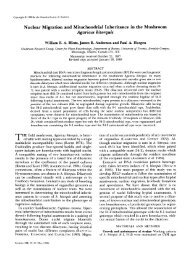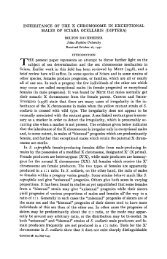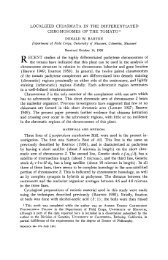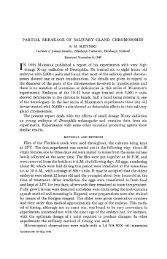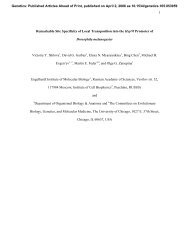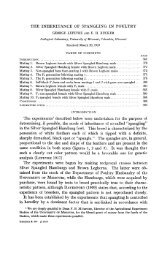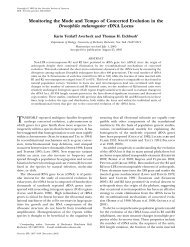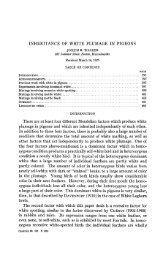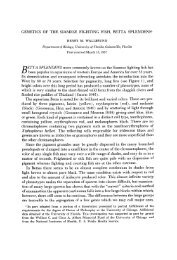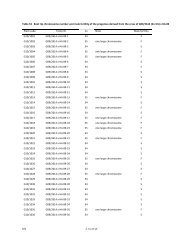abstracts of papers presented at the 1962 meetings - Genetics
abstracts of papers presented at the 1962 meetings - Genetics
abstracts of papers presented at the 1962 meetings - Genetics
Create successful ePaper yourself
Turn your PDF publications into a flip-book with our unique Google optimized e-Paper software.
992 ABSTRACTS<br />
or heterozygote) which is not present in ei<strong>the</strong>r parent. It can be demonstr<strong>at</strong>ed by agglutin<strong>at</strong>ion<br />
<strong>of</strong> <strong>the</strong> cells <strong>of</strong> <strong>the</strong> hybrid following absorption <strong>of</strong> antisera against <strong>the</strong> hybrid with erythrocytes<br />
<strong>of</strong> both parental types.-Repe<strong>at</strong>ed backcrosses to Streptopeia risoria <strong>of</strong> species hybrids and selected<br />
backcross hybrids from respective m<strong>at</strong>ings <strong>of</strong> chinensis, orientalis, and senegalensis with risoria<br />
have resulted in <strong>the</strong> establishment <strong>of</strong> individuals essentially identical to risoria with <strong>the</strong> exception<br />
<strong>of</strong> <strong>the</strong>ir content <strong>of</strong> a gene or genes from one <strong>of</strong> <strong>the</strong> o<strong>the</strong>r species for <strong>the</strong> antigen number 8: ch-8<br />
(formerly called d-If), or-8, or se-8. The contrasting character <strong>of</strong> risoria is design<strong>at</strong>ed ri-8. The<br />
cells <strong>of</strong> each <strong>of</strong> <strong>the</strong> three kinds <strong>of</strong> heterozygotes (ch8/ri-8, or-8/ri8, and se-8/ri-8) invariably<br />
carry a hybrid substance peculiar to itself, but <strong>the</strong> respective homozygotes produced by inter se<br />
m<strong>at</strong>ings do not.-M<strong>at</strong>ings among <strong>the</strong> three homozygotes have produced two new combin<strong>at</strong>ions,<br />
ch-8/se-8, and ch-8/or-8. The cells <strong>of</strong> each <strong>of</strong> <strong>the</strong> three combin<strong>at</strong>ions, ch-8/ri-8, ch-8/se-8, and<br />
ch-8/or-8, possess a hybrid substance which is rel<strong>at</strong>ed to <strong>the</strong> o<strong>the</strong>rs; but each contains antigenic<br />
specificities peculiar to itself. Thus, it appears th<strong>at</strong> different combin<strong>at</strong>ions <strong>of</strong> <strong>the</strong> caus<strong>at</strong>ive genes,<br />
or <strong>of</strong> genes linked to <strong>the</strong>m, produce different interaction products.<br />
VARMA. BASUDEO, ALAN CASPAR, and W. RALPH SINGLETON, Blandy Experimental Farm, University<br />
<strong>of</strong> Virginia, Boyce, Virginia: Effect <strong>of</strong> chronic gamma radi<strong>at</strong>ion on proembryos <strong>of</strong> corn.<br />
-During <strong>the</strong> summer months <strong>of</strong> 1960, corn plants <strong>of</strong> inbred Pr line which are susceptible to <strong>the</strong><br />
leaf spot disease <strong>of</strong> Helminthosporium carbonum were grown in pails. Twenty-four hours after<br />
self pollin<strong>at</strong>ion, <strong>the</strong>y were moved into <strong>the</strong> gamma field and were irradi<strong>at</strong>ed for one day giving<br />
a total dose <strong>of</strong> 1000r. In a few cases, ears showed poor seed settings. In <strong>the</strong> summer <strong>of</strong> 1961, all<br />
<strong>the</strong> seeds obtained from irradi<strong>at</strong>ing <strong>at</strong> <strong>the</strong> proembryo stage were planted in <strong>the</strong> field and selfpollin<strong>at</strong>ions<br />
were made. M<strong>at</strong>ure plants showed differences in <strong>the</strong>ir height, abnormal growth<br />
showing signs <strong>of</strong> chromosomal losses, pollen sterility, etc. In this spring F, seeds have been<br />
tested in <strong>the</strong> green house for any mut<strong>at</strong>ions produced. In a number <strong>of</strong> cases it seems th<strong>at</strong> gene<br />
mut<strong>at</strong>ion have been induced. Seedlings have segreg<strong>at</strong>ed for green and yellow-green characters<br />
in a 3:l r<strong>at</strong>io. Ano<strong>the</strong>r mutant observed is dwarf plants, which also segreg<strong>at</strong>ed in a 3:l r<strong>at</strong>io.<br />
These dwarf mutants died after 20-25 days. O<strong>the</strong>r than <strong>the</strong>se, albino, luteus and japonica type<br />
mutants have appeared. The gre<strong>at</strong> frequency in <strong>the</strong> mut<strong>at</strong>ion r<strong>at</strong>e produced by semiacute gamma<br />
radi<strong>at</strong>ion <strong>at</strong> <strong>the</strong> proembryonic stage is worthy <strong>of</strong> notice. Work is in progress to test <strong>the</strong>se F, seeds<br />
for any resistance induced to Helminthosporium carbonum disease. Results will be discussed.<br />
Complete d<strong>at</strong>a will be <strong>presented</strong> and <strong>the</strong> fundamental importance <strong>of</strong> <strong>the</strong>se findings to radi<strong>at</strong>ion<br />
genetics and plant breeding will be discussed.<br />
VOGEL, H. J., Institute <strong>of</strong> Microbiology, Rutgers University, New Brunswick, N.J.: Lysine<br />
syn<strong>the</strong>sis in some ‘‘algal fungi” and blue-green algae: phylogenetic implic<strong>at</strong>ions.-Among a<br />
number <strong>of</strong> phycomycetes tested, those having ei<strong>the</strong>r anteriorly uniflagell<strong>at</strong>e or biflagell<strong>at</strong>e ZOOspores<br />
syn<strong>the</strong>size lysine via 2,6-diaminopimelic acid (DAP), whereas those having ei<strong>the</strong>r posteriorly<br />
uniflagell<strong>at</strong>e zoospores or aplanospores produce lysine via 2-aminoadipic acid, as do<br />
higher fungi and euglenids (VOGEL, Symposium on Evolutionary Biochem., Fifth Intern. Congr.<br />
Biochem., Moscow, 1961). These studies carried out with <strong>the</strong> aid <strong>of</strong> diagnostic radiocarbon<br />
tracers (3- and &labeled aspartic acids and l-labeled alanine) have now been extended to <strong>the</strong><br />
following phycomycetes with anteriorly uniflagell<strong>at</strong>e or biflagell<strong>at</strong>e zoospores: Rhizidiomyces<br />
sp. (Hyphochytriales) , Thrausto<strong>the</strong>ca clav<strong>at</strong>a (Saprolegniales) , Sapromyces elong<strong>at</strong>us (Leptomitales),<br />
Sirolpidium zoophthorum (Lagenidiales), and Pythium ultimum (Peronosporales) .<br />
All <strong>the</strong>se organisms, in line with <strong>the</strong> above-mentioned generaliz<strong>at</strong>ion, use <strong>the</strong> DAP-lysine p<strong>at</strong>hway,<br />
and thus particip<strong>at</strong>e in an evolutionary continuum which includes green algae, as well as<br />
bacteria and vascular plants (VOGEL, op. cif.). Similar experiments have now shown th<strong>at</strong> <strong>the</strong><br />
DAP-lysine p<strong>at</strong>hway is also employed by <strong>the</strong> blue-green algae, Nostoc sp. and Plectomma<br />
boryanum. (Aided by <strong>the</strong> N<strong>at</strong>ional Science Found<strong>at</strong>ion and <strong>the</strong> Office <strong>of</strong> Naval Research.)<br />
WALTERS, MARTA SHERMAN, Santa Barbara Botanic Garden and University <strong>of</strong> California, Santa<br />
Barbara, Calif.: A nuclear body in meiosis <strong>of</strong> Bromus.-A structure tent<strong>at</strong>ively called a “nuclear





